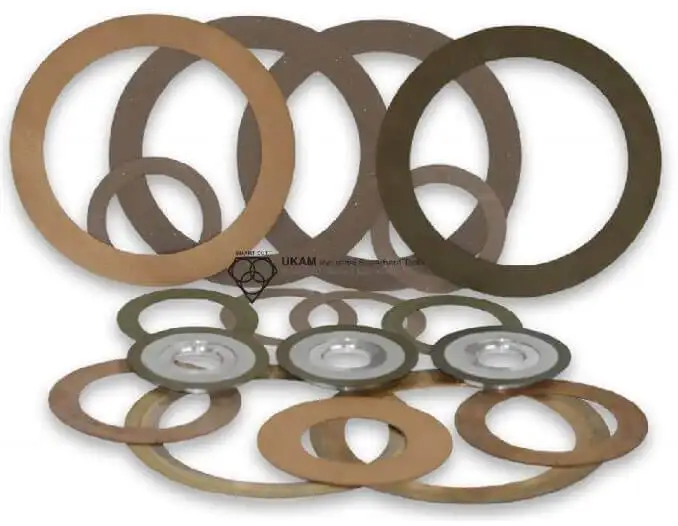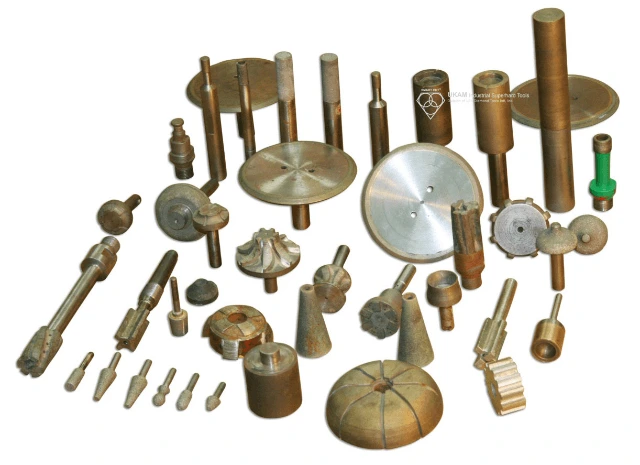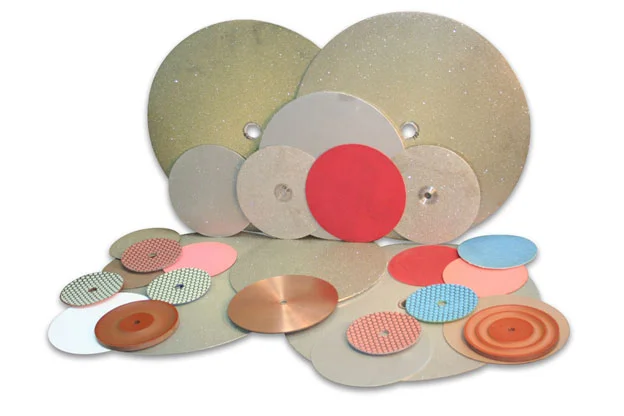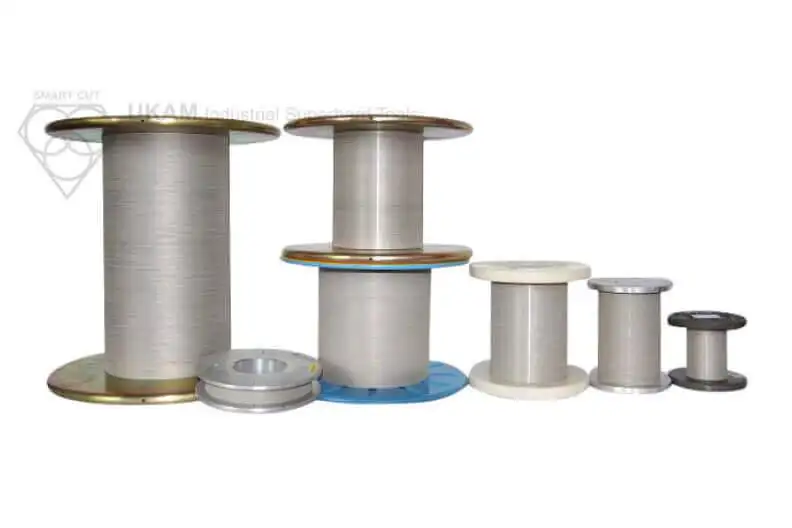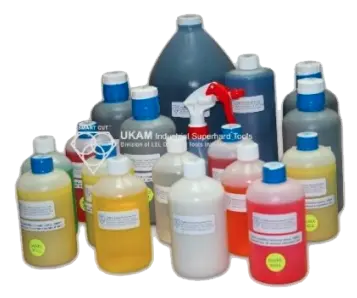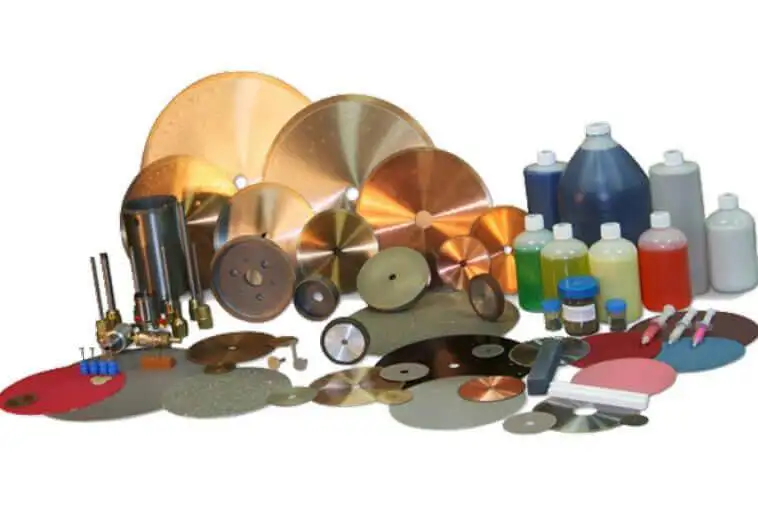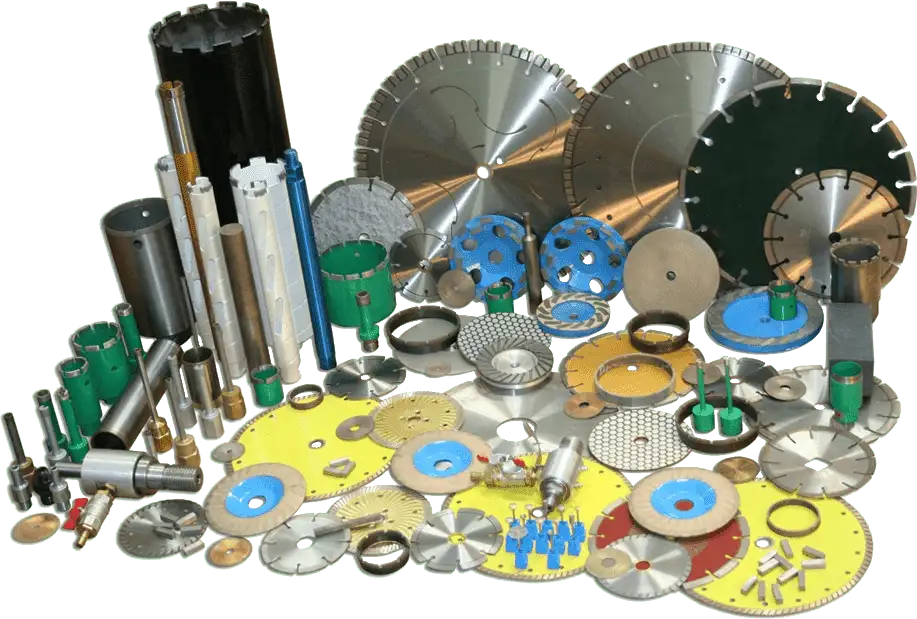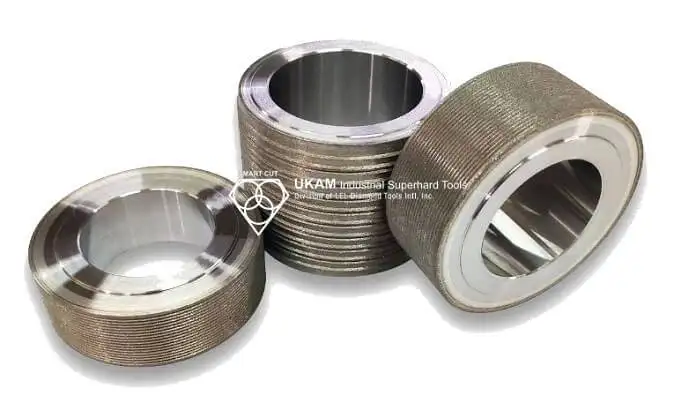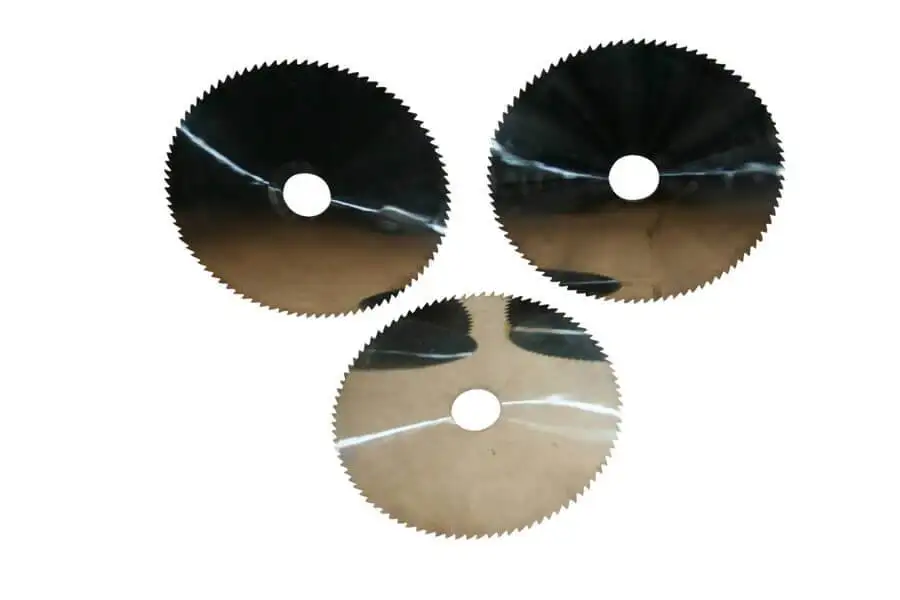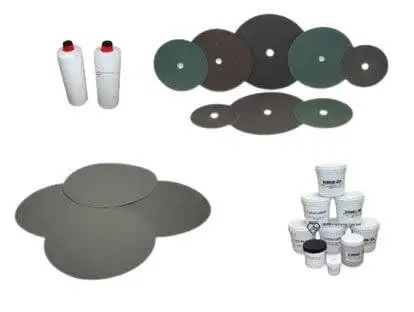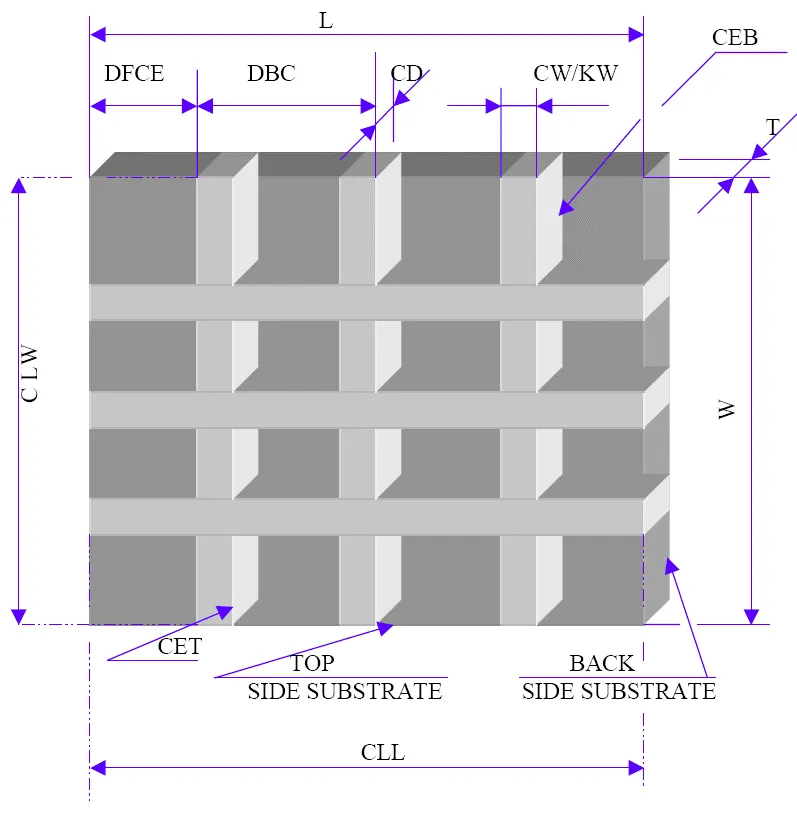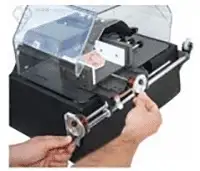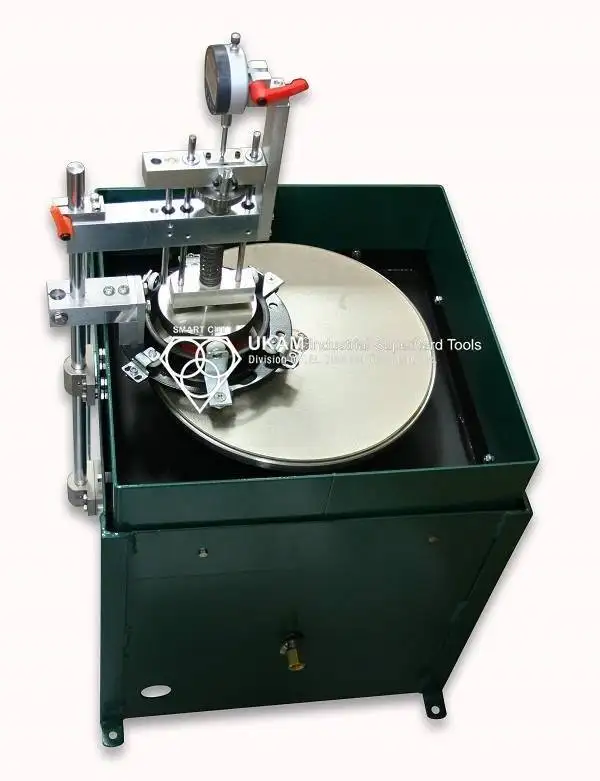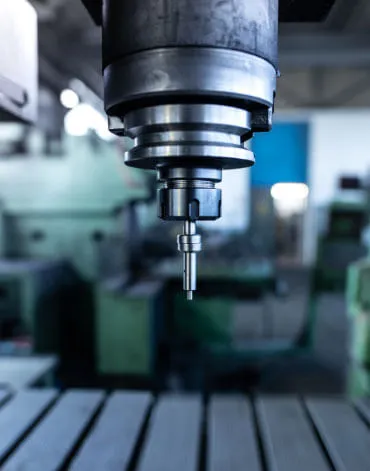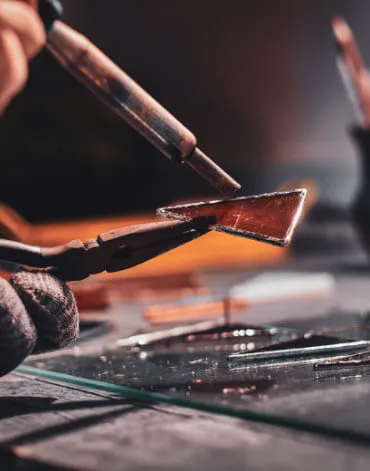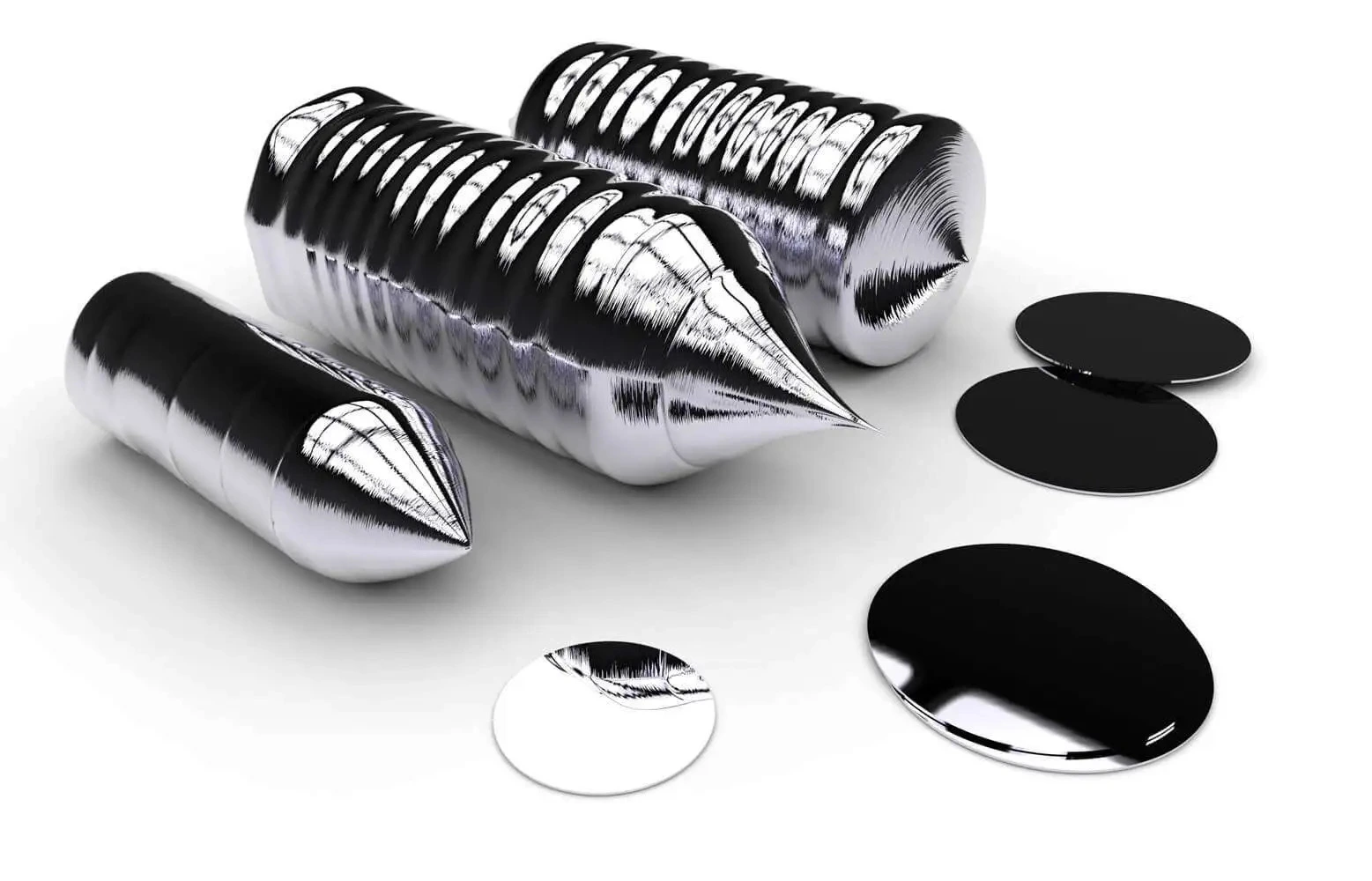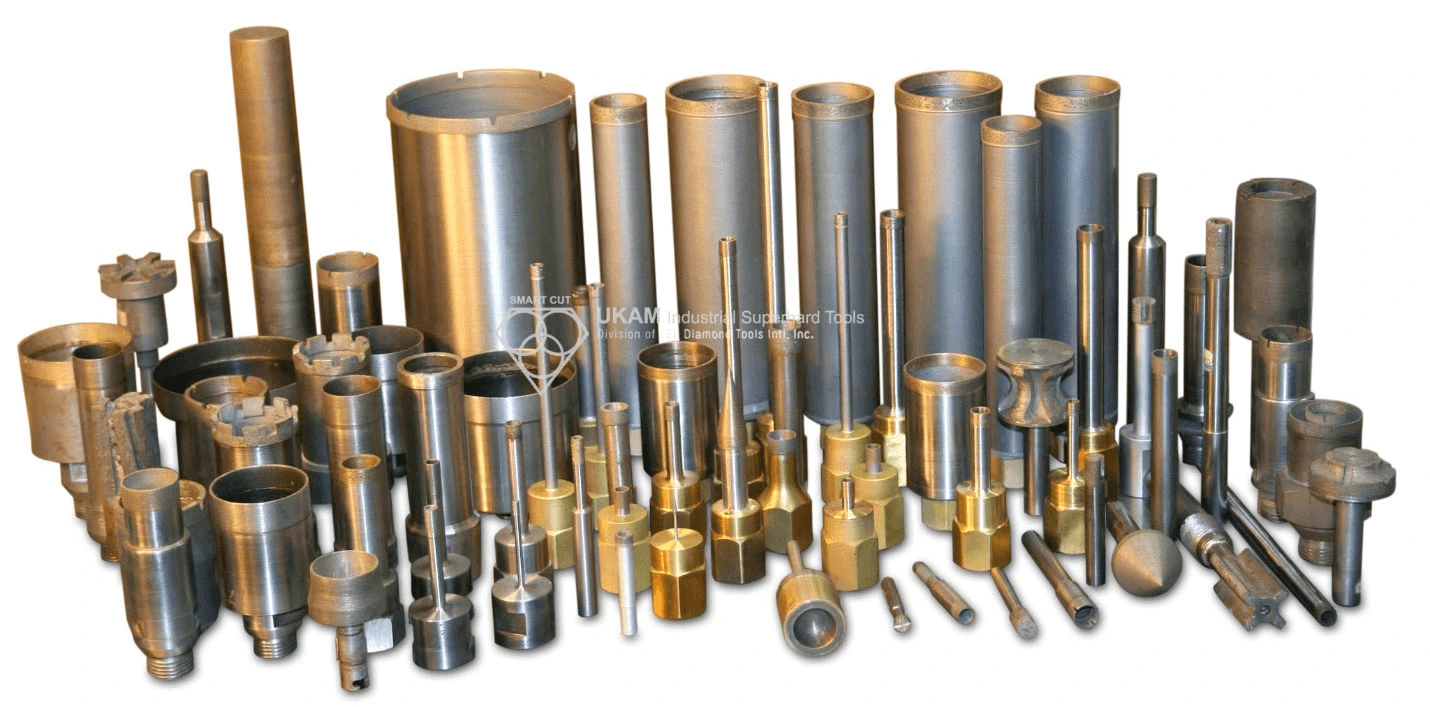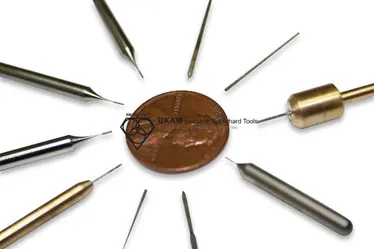How to Properly Use Precision Diamond Drills
-
Posted by
 Alexander Schneider
Alexander Schneider

Table of Contents
ToggleStep by step guide on how to properly use and care for your diamond drills. Selecting the right diamond drill/diamond drill bit parameters, often involves a trial and error process. Many which can be avoided through experience and understanding of how to use these parameter for your specific application.
Share this Article with Friend or Colleague

In order for you to get the most out of your new diamond drill / diamond drill bit, we strongly urge you to read and follow these instructions and suggestions. Doing so will help you save money and time. These suggestions and recommendations have come from years of experience in research, development and manufacturing of precision diamond drills/bits & diamond tools. As well as years of personal experience and observations of diamond drill/bit users like you. The diamond drill/bit itself is only a small factor in your drilling operation. Successful diamond drilling is both an art & science. Requiring proper use and understanding of selecting the right diamond drill for your material / application. Maintaining and using proper.

VARIABLES AFFECTING DIAMOND DRILL LIFE & PERFORMANCE
Selecting the right diamond drill/diamond drill bit parameters, often involves a trial and error process. Many which can be avoided through experience and understanding of how to use these parameter for your specific application. What works for one application, may not work for another. While there is no real substitute for experience, even new diamond drill/bit users can quickly become proficient by learning and applying some basic principles of diamond drilling. Many parts of this guide have been published or presented in several industry magazines or presented at conventions.
Preparation Before Drilling
Safety Precautions and Protective Gear
Visually examine diamond drill for cracks or any other damage. Do not use if damage is suspected. Damaged, incorrectly mounted, our misused drills can be very dangerous to use. Always wear proper safety equipment: Safety footwear, snug fitting clothing, safety goggles, hearing and head protection, and proper respiratory equipment.



Ensuring safety is crucial in any drilling operation to protect both the operator and others in the area. It's important to wear appropriate protective gear, including safety goggles to shield against flying particles, sturdy gloves to prevent cuts, ear protection in noisy environments, and a dust mask or respirator for operations that generate harmful dust. Additionally, always perform machine safety checks before beginning to ensure all equipment is in good condition and that safety guards are properly in place. Familiarity with emergency procedures, including the location and use of fire extinguishers and first aid kits, is also essential..
Preparing the Work Environment
The environment where drilling occurs needs careful attention to enhance safety and efficiency. Keep the drilling area clear of unnecessary items and organize all tools and materials for easy access. Ensure the work area is well-lit and well-ventilated, especially when working with materials that could emit vapors or dust. If the operation is noisy, consider implementing noise-control measures such as enclosing the drill or using noise barriers. Monitoring environmental conditions like moisture levels and dust accumulation is also vital to maintain optimal drilling conditions.
Installing your Diamond Drill or Tool
Installing the diamond drill on to your drilling machine requires attention in order to make sure is properly aligned and functional, which is crucial for achieving precision and avoiding potential damage during drilling
The installation process begins with selecting the right chuck or adapter to ensure that the diamond drill you will be using fits securely into the machine. It’s important to select a chuck or adapter that matches the diameter of the diamond drill shank or mounting in order to prevent any play or misalignment that could affect the drilling accuracy or damage the diamond drill
the diamond drill should be placed inside the collet or chuck making sure there is fit and tightened. This is an important step to make sure stability, with no wobble or misalignment that could lead to inaccuracies or damage.
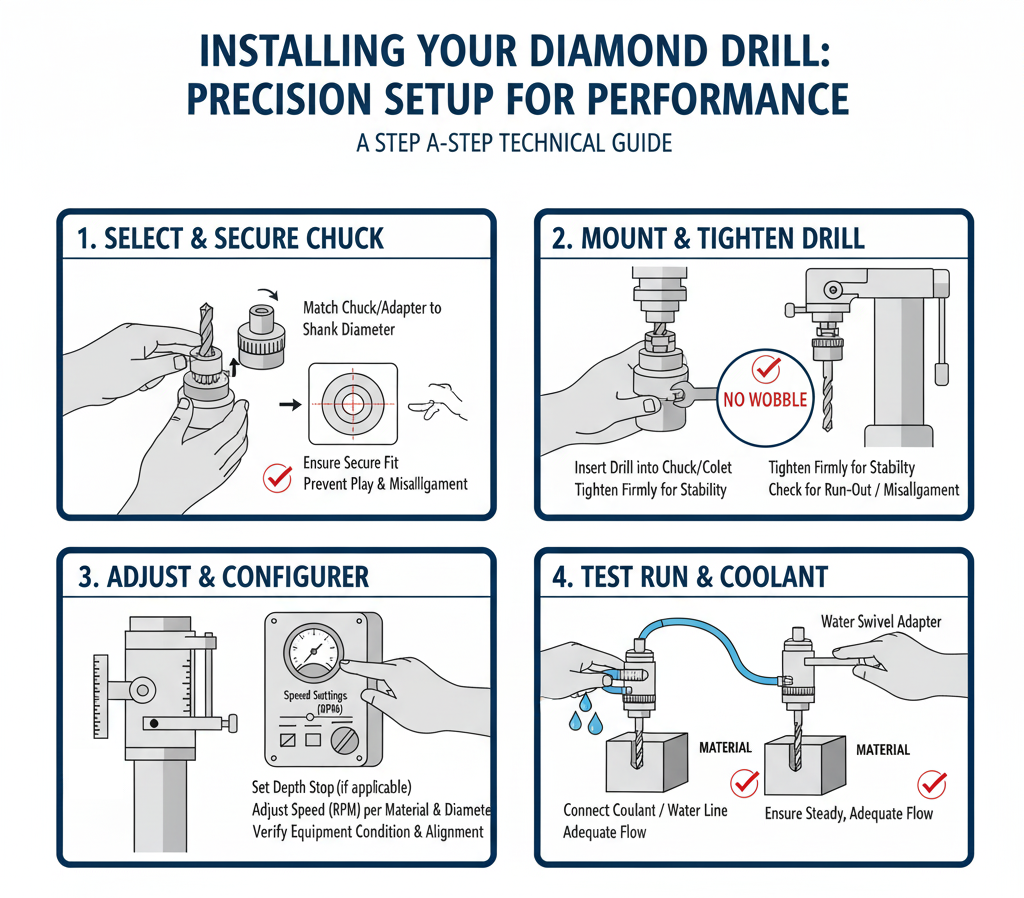
Before starting the drilling process, it's important to set the depth stop, if your machine is equipped with one, to avoid drilling deeper than necessary. Speed settings should also be adjusted based on the material being drilled and the diameter of the drill bit. Different materials require different speeds to optimize performance and minimize wear on the diamond drill.
You should also ensure that your diamond drill or drilling accessories (such as the water swivel adapter) are properly held in the chuck. If the drill or drilling device is not running true, loosen the chuck of your drilling machine, turn it 90 degrees and run your drill again. If this does not work, examine condition of your equipment. Mount the drill on another
drilling machine. Make sure your drilling equipment is in proper condition to accomplish your objectives. No matter how well the diamond drill is made, it will not give you close tolerances if the shaft, or chuck of your drilling equipment is misaligned or vibrates
After the diamond drill is installed, conducting a test run on a scrap piece of the same material or a less critical area is highly recommended. This trial helps verify that the setup is correct, with the machine operating smoothly and the settings appropriately adjusted. Any necessary adjustments should be made based on the results of this test to ensure optimal performance. If using a water-fed drill, the final step involves connecting coolant/water line to the drill. It’s essential to ensure a steady and adequate flow of coolant or water during operation.
Calibration and Alignment
After securing the diamond drill bit and adjusting the settings, it’s crucial to check the alignment of the bit with respect to the target drilling area. Misalignment can lead to uneven wear on the drill bit and suboptimal drilling results. Using precision alignment tools or laser guides, if available, can help in verifying and adjusting the drill bit’s position accurately. Calibration of the machine to ensure that all components are functioning harmoniously can also prevent potential issues during the drilling process.

Checking Diamond Drill/Bit Run Out
Run out will cause excess vibration when your are drilling and effect the circumference (roundness) of your hole. Instead of your hole being perfectly round, it will become ellipse and uneven. Diamond Drill/Bit run out will also affect tolerances you are able to achieve. Every diamond drill is made to hold a specific tolerance and run-out. When ordering diamond drills, make sure to indicate the run-out and tolerance you need. To check for run out, use an indicator specifically designed for this purpose.
Bring the indicator close to drill, until its spring just touches the surface of the drill. The dial of the indicator should indicate 0. Turn on your drilling machine, holding the indicator firmly in place. The dial of your indicator should remain at 0 while your drill is running (rotating). This means you have no drill run out. If your indicator is greater than zero, your drill is running out. Turn off your drilling machine, and remount the drill. A black marker, is an alternative if you have don’t have an indicator available.
Take a piece of paper or any thin piece of material, measuring its thickness using a caliper or micrometer. Place the material firmly against the drill. Holding the marker firmly in place, remove material between drill and marker. Turn on your drilling machine and observe drill rotation. If the marker touches surface of the drill, there is too much drill run out. Turn off drilling machine, and try again.

Another effective way of checking drill run out, is rotate the drill head assembly (including the water swivel adapter, if your drill has this feature) by hand. The run out of the drill diamond section (the cutting/drilling edge) will be indicated by the stem. A strong correlation exists between the run out on the water swivel adapter and on the diamond drill—the larger the run out on the water swivel adapter, the larger the run out will be on the drill. If the run out is not properly indicated, the drilling operation will not be accurate.
You should also ensure that your drilling accessories are properly held in the chuck. If the drill or drilling device is not running true, loosen the chuck of your drilling machine, turn it 90 degrees and run your drill again. If this does not work, examine condition of your equipment. Mount the drill on another
drilling machine. Make sure your drilling equipment is in proper condition to accomplish your objectives. No matter how well the diamond drill is made, it will not give you close tolerances if the shaft, or chuck of your drilling equipment is misaligned or vibrates.
If for some reason you feel there is a manufacturing defect, please return the drill where it was purchased with a note explaining the difficulty. Defective drills will be repaired or replaced. Drills improperly used will be repaired or replaced at users expense.
Starting to Drill a hole

Line up the drill to the material being drilled. Clearly mark the insertion point where you will start drilling. Drill by quickly pressing and lifting the drill head. Moving the drill up and down frequently during the drilling operation will allow the coolant to cool the drill and flush out the material debris formed while drilling. The color of the water in the drilling zone should be milky white. For some hobby applications, you can consider using a pilot, which can easily be made from a piece of wood. A pilot can reduce your drill slippage when starting the hole. Place the pilot on the surface of the material being drilled, with the pilot hole above the insertion point. Doing so will help you maintain the drill in place as you start drilling. When making contact with the material, tip the drill at a 45 degree angle. When you have made a slight indentation, slowly bring the drill to a 15 degree angle, gradually straightening the drill as you penetrate deeper into material. Drill by pressing and lifting the drilling head, down and up frequently to allow water to flush out the material debris formed while drilling and cool the drill at the same time. Do not use extensive pressure. If you find a piece of material debris is stuck inside the drill, take it out before continuing to use.
Using a Pilot
Most pilots are used when drilling existing holes (once the material has already been penetrated). The RPM’s (revolutions per minute) are different than for the drill itself. Often the pilot is worn out before the drill. When drilling harder materials, the pilot should only be used when drilling existing holes. This is not necessary for softer materials such as limestone, sandstone, and fiberglass. You can start drilling with drill and pilot right away. A pilot is a drill guide, usually made from 2” x 4” piece of metal or wood.
ADVANTAGES of using a pilot with your drill:
-
 - Center the outside hole
- Center the outside hole
-
 - Make sure the drill will not walk
- Make sure the drill will not walk
-
 - Keep the drill as rigid as possible
- Keep the drill as rigid as possible
Securing your material while drilling

MECHANICAL CLAMPING/FIXTURING

TAPE MOUNTING WITH VACCUM CHUCK

DOUBLE SIDED ADHESIVE TAPE

WAX/GLUE MOUNTING TO MEDIA

WAX/GLUE MOUNTING TO MEDIA
It is extremely important that the part you are drilling is clamped down and hold securely in place. So material does not move, if material does move while drilling it may break the diamond section of your drill. A clamp should be used for this purpose. Do not hold the part (material) with your hands. Doing so is dangerous, and your material will chip. For drilling thinner materials and substrates consider using heavy duty double sided tape to firmly hold your material in place.

Drilling Speeds
To maximize the life of your drill and minimize material damage, it is important to run your drills at the proper drill speed and pressure. Drilling speeds vary with diameter of diamond drill, diamond mesh size, coolant being used, diamond bond type and hardness, as well as material hardness. Micro Diamond Drills from .001” required drilling speeds as high as 150,000+ RPM. Whereas very large diamond drills 48” diameter require drilling speeds as low as 3 RPM’s.
Below is a chart of Recommended RPM's (speeds) in correlation to diamond drill/bit diameter. Please note this chart is for reference purpose only to be used as starting point only. RPM's will vary with
material being drilled, material hardness, density, geometry, drilling depth, environment, and operator objectives.
DIAMETER
RECOMMENDED RPM'S
.001” to .004”
300,000 to 450,000
.005” to .015”
65,000 to 150,00
.016” to .030”
30,00 to 65,000
.031” to .090”
9,000 to 30,000
1/8” (3.18mm)
2,500
3/16” (4.76mm)
2,250
¼” (6.35mm)
2,000
5/16” (7.94mm)
1,500
3/8” (5.52mm)
1,250
7/16” (11.1mm)
1,000
½” (12.7mm)
950
9/16" (14.28mm)
925
5/8" (15.87mm)
875
2/3" (16.93mm)
850
11/16" (17.46mm)
850
3/4" (19.05mm)
825
7/8" (22.22mm)
775
1.0" (25.4mm)
700
1-1/8" (28.57mm)
675
1-1/4" (1-1/4mm)
650
1-3/8" (34.92mm)
600
1-1/2" (38.10mm)
550
1-5/8" (41.27mm)
550
1-3/4" (44.45mm)
550
2.00" (50.80mm)
525
2-1/4" (57.15mm)
500
2-1/2" (63.50mm)
475
3.00" (76.20mm)
450
3-1/2" (88.90mm)
425
4.00" (101.60mm)
400
6.00" (152.40mm)
300
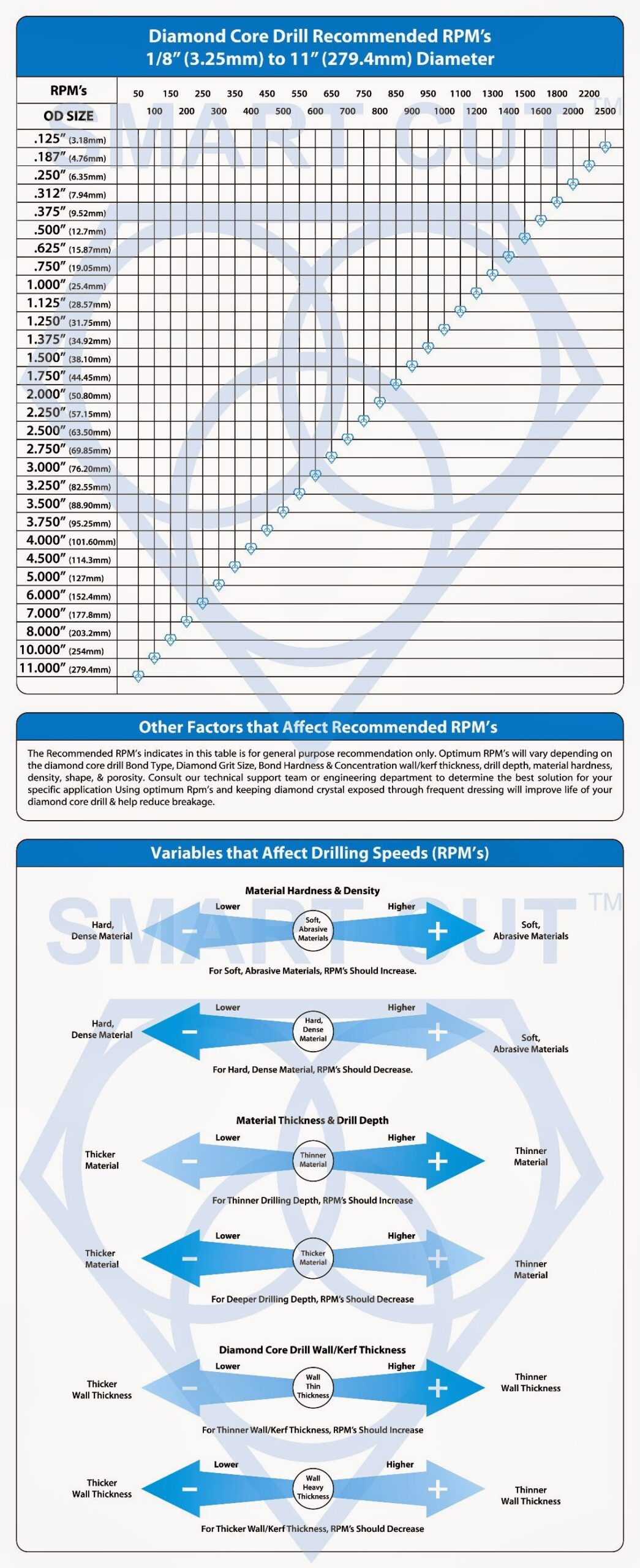
Soft, abrasive materials can typically handle higher drilling speeds, while hard, dense materials require much slower speeds. Faster drilling might appear to increase your production efficiency, but the tradeoff is a significant increase in friction and heat, which considerably reduces the drill life and increases the risk of heat fractures and breakage in the material being drilled.
Meaning if a diamond core drill develops dark “burn” marks at the diamond section, the drill is being used is too fast or the amount of pressure is too great. Reduce drilling speed or adjust pressure accordingly. It is generally recommended that you use a drill as fast as it will drill freely. Find out more about RPM's >>>

Drilling with Coolant
Coolant must always be used during diamond drilling. The most common cause of diamond drill damage or premature wear is insufficient coolant flow. Most diamond drills should never be operated dry. Coolant performs three critical functions: it reduces heat, lubricates the drilling interface, and flushes out abrasive particles and debris that can cause binding, surface scoring, or excessive tool wear.
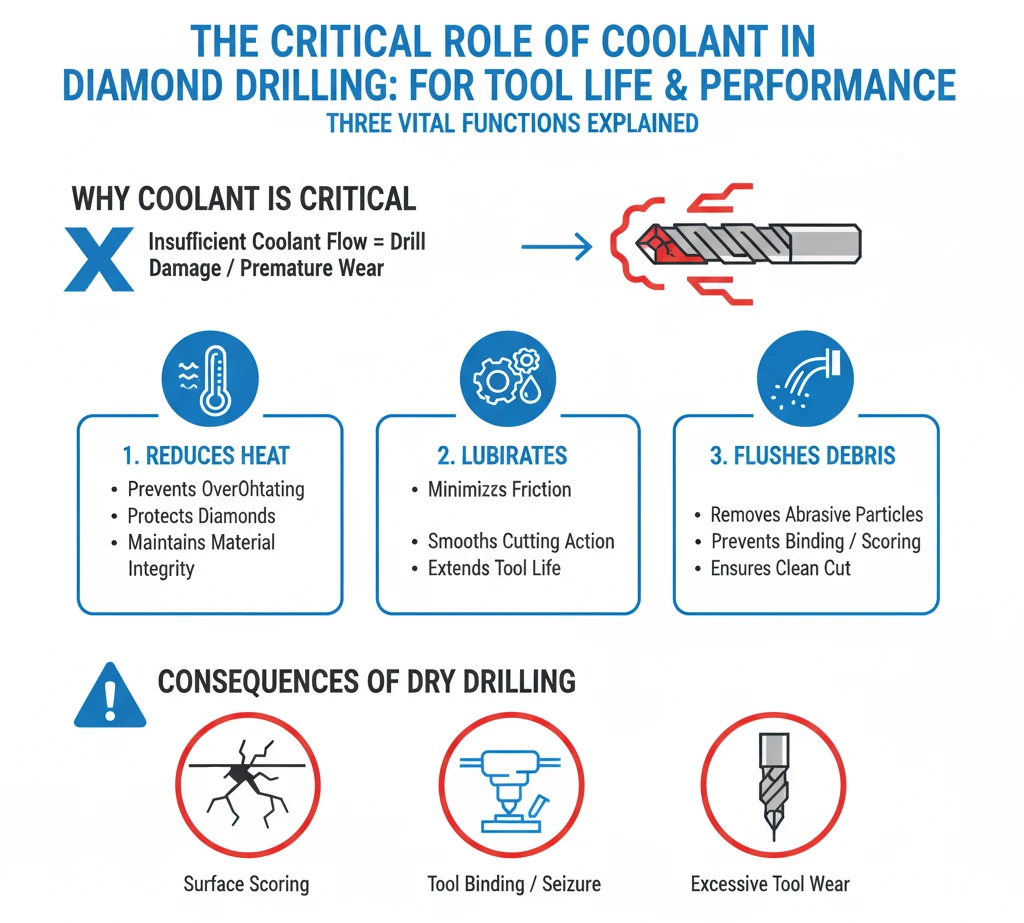
When coolant is not supplied adequately, temperatures can exceed 700°C, causing diamond crystals to break down and transform into carbon. This process, known as graphitization, weakens the bond structure and leads to rapid diamond loss and premature tool failure. This is known as thermal degradation issue.
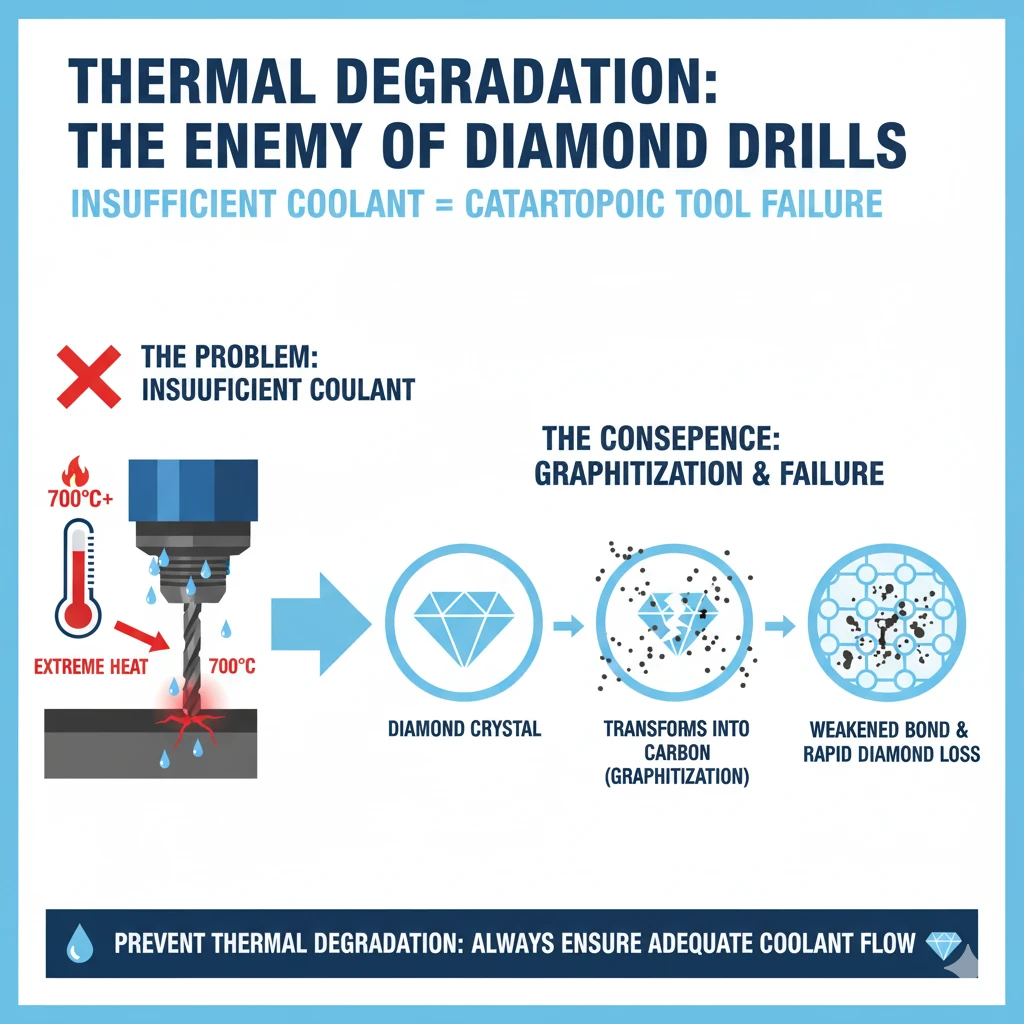
Water is the most frequently used coolant, mainly because it is inexpensive, readily available, and easy to apply. However, plain water is not a highly effective coolant on its own. It provides limited lubrication and can increase friction between the drill and the material. Water also tends to evaporate quickly at high temperatures, reducing its cooling efficiency during continuous or high-speed drilling. In addition, water lacks the ability to prevent corrosion or oxidation of the metal bond and drill body.
For improved performance, water should be used with additives or specialized coolants designed for diamond drills & tools. Water-soluble synthetic coolants such as SMART CUT® water soluble coolant significantly enhance lubricity, heat dissipation, and corrosion resistance. These mixtures also help suspend and remove abrasive particles from the cutting zone more effectively than water alone. Proper concentration and continuous circulation are necessary to maintain optimal coolant properties.
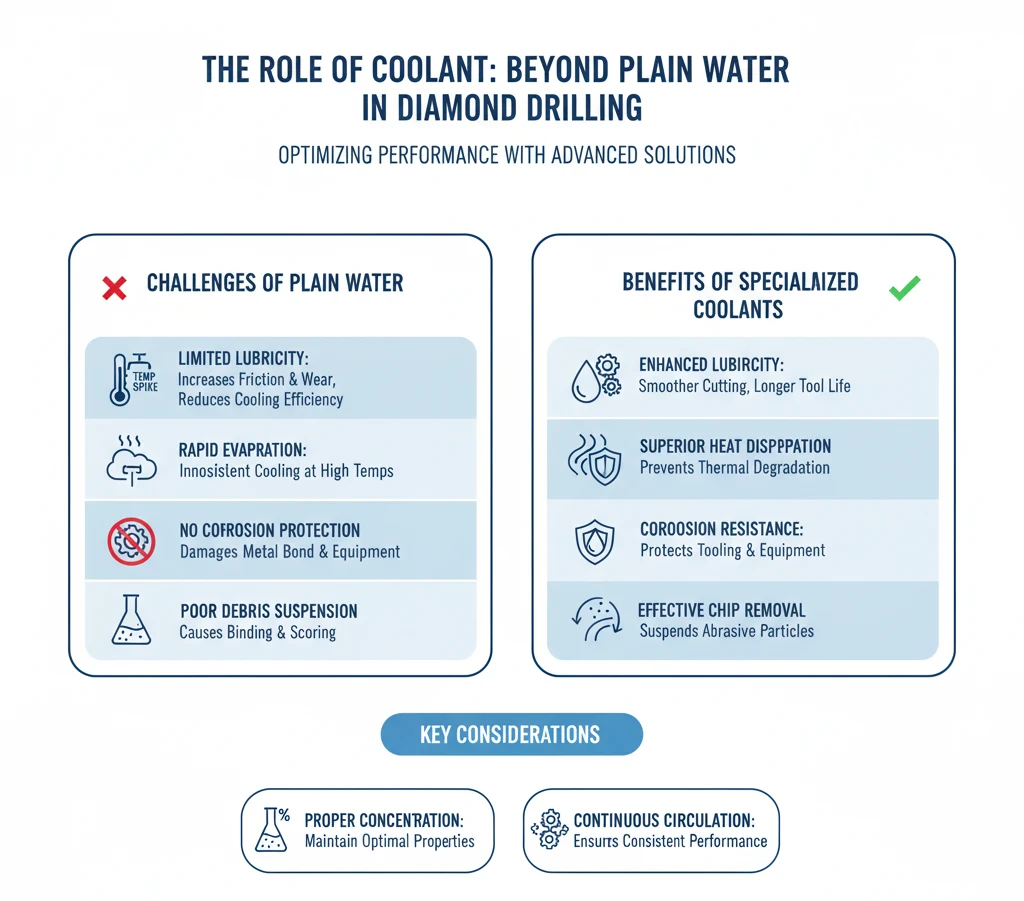
For dense alloys or metals, light mineral oils or formulated oil-based coolants may be used. They offer superior lubrication but lower heat transfer efficiency compared to water-based fluids and can leave an oily residue. In certain limited situations where liquid coolants are not suitable, such as in electrically sensitive or dry machining environments, air or mist cooling systems can be applied. These methods provide minimal heat removal and should only be used for low-speed or shallow drilling operations.
Before starting any operation, it is essential to confirm the appropriate coolant type, pressure, and flow rate with the drill manufacturer. When synthetic or additive-based coolants are used, a recirculating system must be employed to maintain a consistent ratio and supply. The coolant stream must always be directed precisely at the contact zone between the drill and the workpiece to ensure effective cooling, lubrication, and chip evacuation.
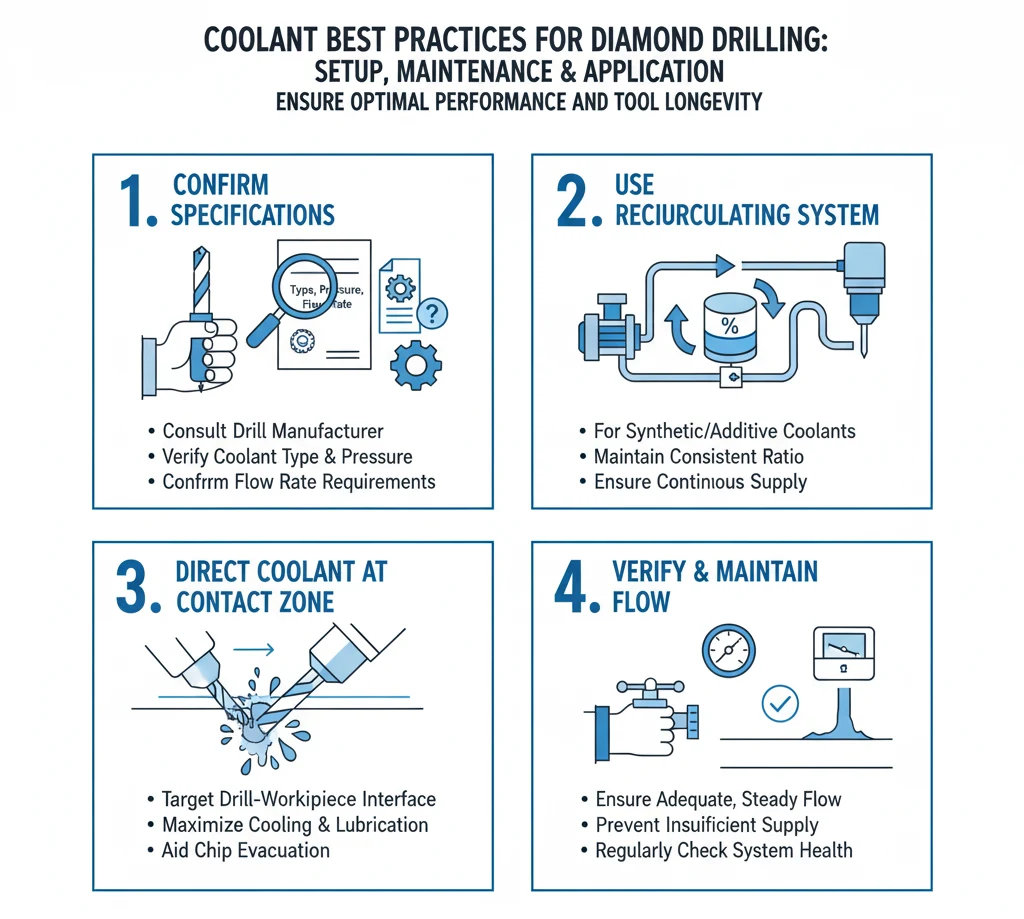
Coolant Usage Suggestions & Recommendations:
Drilling on a horizontal surface
-
 Use a squirt bottle or even a small cup of water to continuously pour water onto the drilling zone. Observe hole to make sure enough lubrication is reaching the drill.
Use a squirt bottle or even a small cup of water to continuously pour water onto the drilling zone. Observe hole to make sure enough lubrication is reaching the drill.
-
 Submerge the material into a tub of water. So water just touches material surface.
Submerge the material into a tub of water. So water just touches material surface.
Drilling on a vertical surface
-
 consider using a water swivel adapter to provide coolant through the center of your drills. Water swivel adapters provide the most efficient and effective method of coolant.
consider using a water swivel adapter to provide coolant through the center of your drills. Water swivel adapters provide the most efficient and effective method of coolant.
-
 should you find yourself in a situation where a water swivel adapter cannot be used, use a garden type of hose which can be easily obtained from any hardware store.
should you find yourself in a situation where a water swivel adapter cannot be used, use a garden type of hose which can be easily obtained from any hardware store.
-
 if this is not possible, use a squirt bottle to provide coolant to your drilling zone.
if this is not possible, use a squirt bottle to provide coolant to your drilling zone.

Water Swivel Adapters
Water Swivel adapter cools both diamond core drill and material in zone of drilling. Water swivel adapters come with a valve for adjustable water flow. On Average, diamond drills used with water swivel adapters will last 40% to 75% longer.
Diamond Core Drills used with water swivel adapter will not overheat material and prevent cracks that occasionally arise from drilling. Find out more >>>
UKAM Industrial Superhard Tools manufactures water swivel adapters to fit just about any drilling equipment. When considering using a water swivel adapter, make sure it is designed to be used with RPM’s you are planning to run your drills. Water swivel adapters that are made from stainless steel, ball bearings, and with adjustable water flow, are preferable over water swivel adapters made from brass and no bearings.
Water Swivel Adapters are generally used with diamond drills that are mounted on a collet with female thread.
Water swivel adapters are designed to fit all standard thread sizes such as 5/8-18”, ¾-16”, 5/8-11”, ½” gas and many others. Diamond solid drills and most Electroplated (nickel bond) Diamond Drills are usually made with a straight shank and not designed for coolant to run through center of drill, should be used submerged with coolant.
Why use Water Swivel Adapter to run high pressure of coolant through center of your diamond drill?
-
 Best and most efficient way of drilling ultra hard materials
Best and most efficient way of drilling ultra hard materials
-
 Best & most efficient way to obtain (extract) core samples
Best & most efficient way to obtain (extract) core samples
-
 Improve surface finish quality and reduce material chipping
Improve surface finish quality and reduce material chipping
-
 Increase Diamond Drill Life 40% to 75%
Increase Diamond Drill Life 40% to 75%
-
 Increase Drilling Speed & Feed Rate
Increase Drilling Speed & Feed Rate
-
 Prevent micro cracks that occasionally arise from heat generated while drillings
Prevent micro cracks that occasionally arise from heat generated while drillings
-
 Preserve material true micro structure
Preserve material true micro structure
-
 Obtain More Consistent overall performance
Obtain More Consistent overall performance
-
 Optimize your Diamond Drilling Operation to ultimate point of efficiency
Optimize your Diamond Drilling Operation to ultimate point of efficiency
Coolant pressure
You will find the more pressure you have on your coolant, usually the better your drilling results will be. Strong coolant pressure will wash out material debris (center plugs) stuck in center of your drill. Center plugs restrict coolant flow to center of drill and prevent coolant from reaching the diamond section. Your drill swill start to drill dry, significantly reducing your drill life, material surface finish, and deteriorating overall performance. Center plugs preventing water reaching the diamond section, are behind 90% of all drill wreckage.
Using Coolant through center of your drills
When drilling with diamond drills, the proper use of coolant is important for two reasons.
Minimize Drill & Material Overheating
Frictional heat produced at the working face of diamond tip must be disposed immediately. Otherwise the diamond become rapidly damaged by oxidation and graphitization. Excessive heat generated while drilling will also damage the metal matrix holding the diamonds in place.
Insure Drilling Consistency
Debris generated while drilling should be removed as soon as they are produced. When this drilling debris is not removed rapidly, diamond wear increases through abrasion caused by the presence of excessive coarse stone fragments.
Water is the most common coolant used for many drilling applications. It is always a good idea to pump an adequate supply of water or coolant through the center of the drill. So that an uninterrupted flow is maintained flushing across the working surface of the drill diamond section. In this way diamonds and the metal matrix are both kept sufficiently cool. And material debris is removed as soon as it is produced. This is the most optimum condition for your drill.
Reduce Friction between material and drill
Water/coolant also penetrates the micro-cracks witch are generated upon impact of material and diamond drill. Under ideal conditions, the material will absorb water/coolant, hence becoming completely saturated with water/coolant. In this state the material is weaker and more easily drillable.
The coolant surface tension also plays an important part in the drilling operation. Usually the lower the surface tension, the easier it is for the coolant to enter the micro cracks. Coolant with a lower surface tension also wets the diamonds more easily. Most users find that by lowering the surface tension of their coolant, resulted in better cooling (wetting) of their diamond, and more effective overall cooling. Lower surface tension also improves material debris lubrication, promoting efficient removal.
Applying Pressure to Drill
It is also very important to apply the right amount of pressure during drilling. Use light to medium pressure, gradually feeding the drill into the material, until the drilling begins to progress at its own speed. Increasing pressure on the drill will do little to reduce the time it takes you to complete a hole, but it will cause your drill to overload and overheat, which will lead to excessive wear on the drill and defects in the material being drilled.
When you are drilling completely through a piece of material and the hole is near completion, reduce the drill pressure considerably to minimize chipping of the material. Never force a diamond drill. Apply even pressure until the drill and material just touch. Since the drill and material surface are not perfectly even (symmetric) to each other, this lets the drill surface become sharper and adjust to the surface of material. If a diamond core drill develops dark “burn” marks at the diamond section, the drill speed is probably too high or the amount of pressure is too great. Reduce the drilling speed or pressure accordingly.

Feed Rates
Feed Rates refer specifically to the speed at which the drill advances into the material, typically measured in millimeters per minute or millimeters per revolution. This determines how quickly the drill cuts into the material with each rotation. This parameter is critical as it directly influences the efficiency of the drilling process, the quality of the cut, and the lifespan of the drill bit itself. Proper management of feed rates can optimize performance and minimize the risk of damage to both the diamond drill and the workpiece. Additionally, correct feed rates prevent excessive wear on the drill, extending its lifespan and improving cost-efficiency.
Setting the correct feed rate is a balancing act: too fast can lead to overheating and premature wear or even breakage of the diamond drill, while too slow can decrease efficiency and unnecessarily prolong the drilling process.
Determining Feed Rates
Feed rates are determined by several factors including:
-
 Material Hardness and Abrasiveness: Harder materials generally require slower feed rates to reduce the risk of overheating and wear on the diamond crystals. Conversely, softer materials can be drilled at higher feed rates.
Material Hardness and Abrasiveness: Harder materials generally require slower feed rates to reduce the risk of overheating and wear on the diamond crystals. Conversely, softer materials can be drilled at higher feed rates.
-
 Diamond Drill Specifications: The size and type of the diamond drill, including the diamond grit size, concentration, and the bond material, significantly influence the optimal feed rate.
Diamond Drill Specifications: The size and type of the diamond drill, including the diamond grit size, concentration, and the bond material, significantly influence the optimal feed rate.
-
 Coolant Use: The type and flow of coolant can affect how fast a drill can operate. Effective cooling improves cutting speeds and extends the life of the diamond drill.
Coolant Use: The type and flow of coolant can affect how fast a drill can operate. Effective cooling improves cutting speeds and extends the life of the diamond drill.
-
 Machine Capability: The power and precision of the drilling equipment also determine how effectively a feed rate can be implemented without causing damage or deviation in the hole.
Machine Capability: The power and precision of the drilling equipment also determine how effectively a feed rate can be implemented without causing damage or deviation in the hole.
Using Submerged Pressure
Using frequent up and down motion when drilling will help propel coolant deeper into the hole being drilled. It is highly recommended that drilling should be done in even intervals. Drilling for about 30 seconds, lift diamond drill up from drilling zone to let it cool in air and diamond and coolant reach further into the drilling zone. Following this technique will reduce pre-mature and uneven diamond drill wear and avoid diamond drill/bit wreckage.
Using a Pecking Cycle
The pecking cycle, also known as peck drilling or step drilling, is a drilling technique used primarily with diamond drills to enhance the efficiency and precision of the drilling process, especially in tough and brittle materials. This method involves intermittent withdrawal of the drill bit during the drilling process to clear away debris and to allow cooling, thereby improving the overall performance and longevity of the diamond drill
To implement the pecking cycle effectively, operators should adjust the drilling machine’s settings to control the depth of each "peck" and the frequency of retraction. The specific parameters will vary depending on the material being drilled and the characteristics of the drill bit. Modern CNC machines and advanced drilling equipment often have built-in settings to automate the pecking cycle, ensuring consistency and precision in the drilling process.
In a pecking cycle, the diamond drill is intermittently withdrawn from the material being drilled. This periodic retraction serves several important purposes. It helps remove debris, preventing blockages and maintaining a clean drilling path. The cycle also allows the diamond drill to cool down, preventing overheating and extending its lifespan. By reducing continuous contact, it decreases friction and heat generation. Each retraction allows for better control and repositioning, ensuring precise drilling. Additionally, it distributes the workload more evenly, reducing wear and tear on the drill bit, and improving its overall durability.
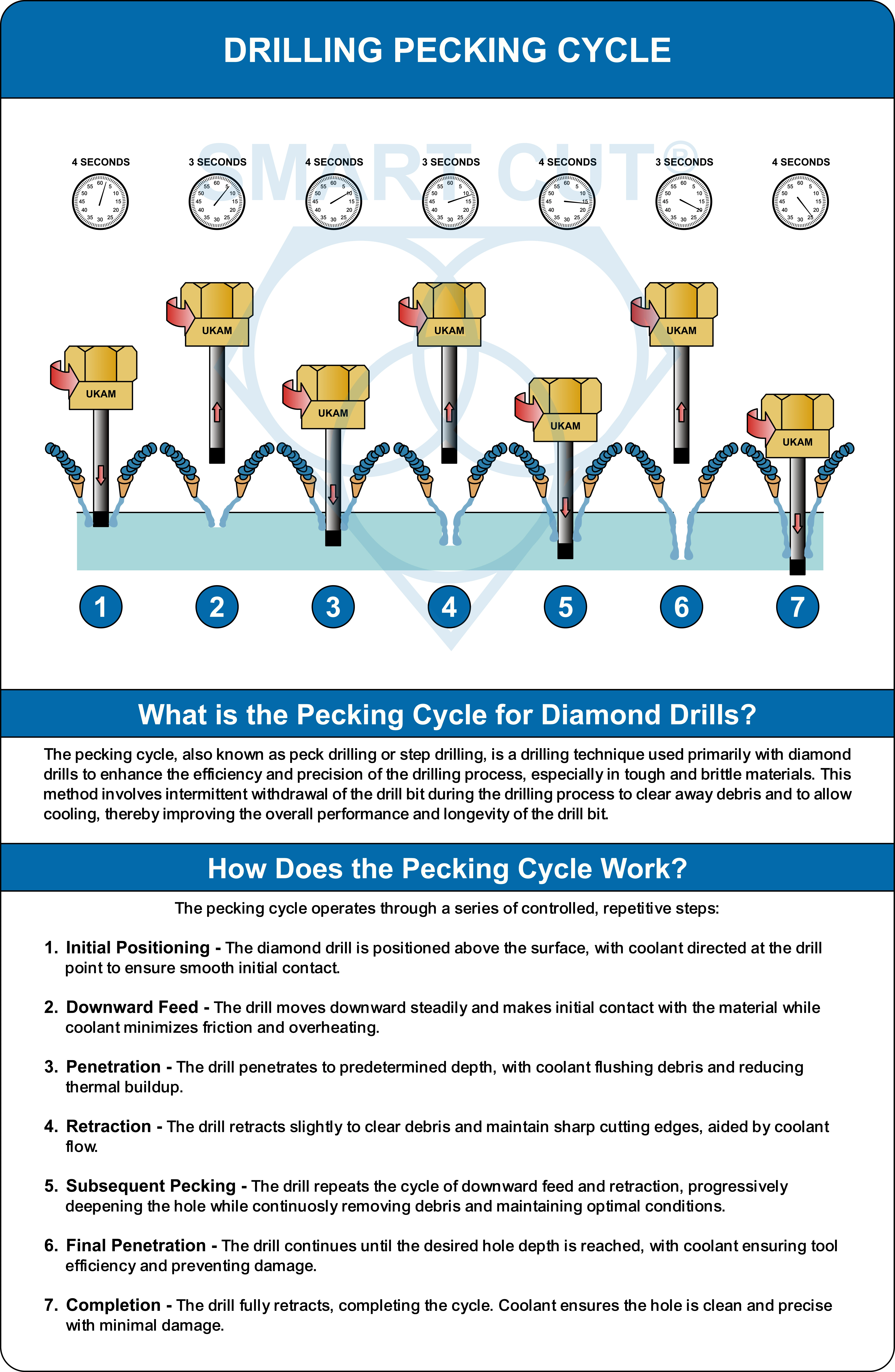
How Does the Pecking Cycle Work?
The pecking cycle operates through a series of controlled, repetitive steps:
1. Initial Penetration:
The diamond drill bit makes initial contact with the workpiece and begins drilling a short distance into the material.
2. Retraction:
After drilling to a predetermined depth, the drill bit is retracted slightly to clear away accumulated debris (swarf) and to facilitate cooling. This retraction helps to prevent clogging and reduces the risk of overheating.
3. Debris Removal:
The retraction allows any coolant or lubricant to flush out the debris from the hole, ensuring a clean drilling environment. This step is crucial in maintaining the cutting efficiency of the diamond drill bit.
4. Cooling:
The cooling phase during retraction helps to dissipate the heat generated during drilling. Effective cooling prevents the diamond drill bit from overheating, which can cause premature wear or damage.
5. Resumption of Drilling:
The drill bit is then advanced further into the material, repeating the cycle of drilling, retraction, debris removal, and cooling until the desired hole depth is achieved.
Balancing Drilling Speed, Pressure and Coolant
Drilling speeds are affected by the hardness and abrasiveness of the material, age and condition of equipment, pressure and coolant. Experience with a specific material and applications allows the operator to develop the right drilling process for their particular application, and taking into account all of the factors discussed above. New users, who are just beginning to drill with diamond drills, are better off starting to drill at low speeds, low pressure and with a large amount of coolant. Until they are able to build their experience using a specific diamond drill, set up, and application. Doing so will minimize the risk of diamond drill and material damage.
Drilling Depth
When drilling with core drills in material over 1/2" thick, it is recommended to drill to a depth of about 1/2", then remove material debris with a chisel or screwdriver before continuing to drill. If you are using a water swivel adapter, increase the water pressure until, the debris stuck inside is flushed out. If you are drilling a thick piece of material, repeat this process several times. Continuing to drill without removing material debris stuck in the center will cause the drill to burn up, since enough coolant is unable to reach the drill.
Applications require drilling depth of not more than 1”. Applications requiring you to drill over 1” should be tread in a different way. We recommend running coolants from multiple directions. Through drill center, from side of drill, as well as drilling submerged in coolant. This will insure maximum amount of coolant and lubrication reaching your drilling zone. Apply more pressure and reduce speed the deeper you penetrate into your material. Lift drill up, after every inch drilling into your material, letting the drill cool and coolant reach deeper into your hole. Carefully examine the diamond tip condition, making sure its round, and not overheated.
Your maximum drilling depth will also be limited by spindle travel. The distance your drilling equipment can move in an upward and downward motion before touching the surface of your material. Make sure to take this into consideration when ordering diamond drills.

Extending Drilling Depth
Diamond Drills usually have a drilling depth of about 2" to 2-3/4", with the shaft being 1" to 2" long and the diamond depth (diamond section) being about 8mm. When drilling deep holes, beyond the diamond drill depth, the drill chuck may come into contact with the surface of the material being drilled. A drill tube extension can be used to lengthen the the drill drilling depth. Various sized tubes (core drill) extensions can be purchased at most hardware stores, building, contractor, and do-it-yourself supply centers.
Applications requiring you to drill over 1" (25.4mm) should be tread in a different way. We recommend running coolants from multiple directions. Through drill center, from side of drill, as well as drilling submerged in coolant. This will insure maximum amount of coolant and lubrication reaching your drilling zone. Running high pressure of coolant through center of your diamond drill/bit by using a water swivel adapter is highly recommended for drilling material over 1" (25.4mm) Thick. Longer Drilling depths may require drilling in several steps and using more than one diamond core drill / diamond drill bit.
Small Diameter Drills
Small diameter diamond drills must be used at significantly higher speeds than larger size drills. It has been found that higher Revolutions Per Minute (RPM’s) improve surface finish and overall drilling performance. RPM’s for diamond solid drills .001” to 2.5mm (without center hole for coolant flow capabilities) range from 9,000 to 450,000. Find out more about our minature & micro diamond drills & tools >>>


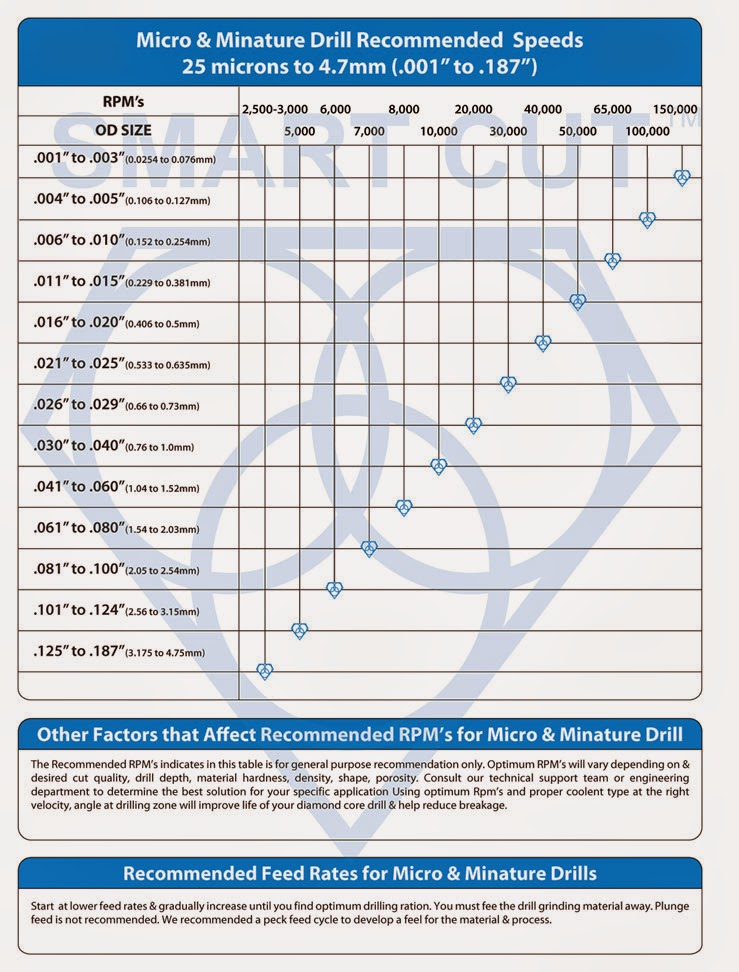
Drilling equipment that can accommodate these speeds include: high speed air spindles, hand held drills, and other specialty micro drilling equipment. High speed air spindles can run up to 450,000 RPM, hand held drilling machines to 35,000 RPM, and specialty micro drilling equipment up to 25,000 RPM. All diamond solid drills and diamond micro drills must be used with coolant. We recommend either drilling submerged in coolant, or applying air as coolant (in some cases), if other liquid coolant types cannot be used.
Smaller size diamond core drills 1.6mm to ½” (mounted on a collet with thread and designed to run coolant through center of drill) must run with high pressure of coolant 45 PSI through center of drill. This is the key successful drilling very hard materials. Drilling submerged in coolant is not recommend. Once the core (material debris) becomes stuck inside the drill, coolant is blocked off from the drilling zone, and the drill can no longer be used.
It is very important that you periodically check the inside of the drill for material clog up. If you spot the material core becoming clogged up, flush out this debris using coolant pressure from a water swivel adapter or other coolant source. Continue drilling only after the debris has been removed. We recommend that you use diamond core drills 1/2" and above on a drill press. How to use Diamond Micro Drills - Find out more >>>

Dressing Diamond Drills
Most Diamond Drills can be dressed (retrued) several times. Usually the wear on the diamond drill depth takes place on the drill core and diamond section, as well as wall thickness. A diamond drill can be retrued by facing off the drill depth with a SiC wheel to the point where the wall thickness is standard. Retrueing (dressing) causes diamonds to be pulled out from the drill diamond section (diamond tip). For this reason, great care should be taken to reduce this effect.
Find everything you wanted to know about dressing diamond & cbn tools >>>
We suggest rexposing the diamond section with a Al203 stick after retrueing. This is a very simple operation: just drill into the dressing stick a few times.
Diamond core drills may require dressing. Dressing clears the bottom of the drill from “glaze” and exposes new sharp diamond on end or bottom the diamond core drill. It is the bottom of the drill that does all the cutting, not sides of the drill. When the drill is “glazed” an excessive amount of pressure is required to drill. Excessive chipping or breakout may result in the work piece. DO NOT DRESS SIDES OF THE DRILL
HOW TO DRESS
Start by drilling in approximately ¼” (6mm) deep into the stick, this should be done two to three times (when drill is seriously glazed over, it may be required to drill as many as 20 times into this dressing stick to correct the problem). MAKE SURE TO KEEP COOLANT FLOWING. Coolant should flow over the dressing stick. Dressing without coolant is worse than not dressing at all.
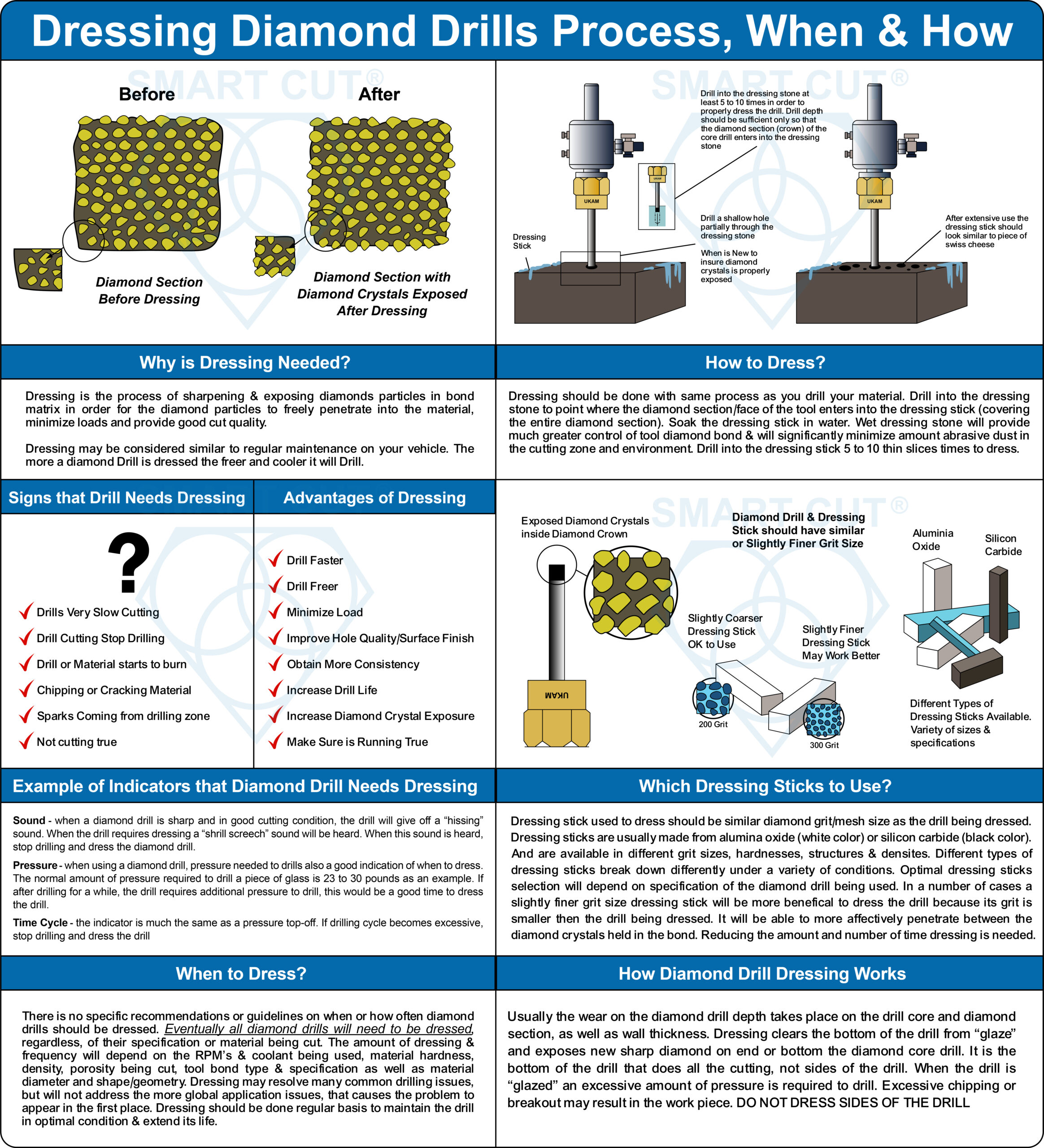
WHEN TO DRESS:
There is no easy, straightforward answer to this question. Conditions such as material being drilled, depth of hole, drilling conditions, all play a factor on when a diamond drill should be dressed. Here a few tips in detecting when your diamond drill should be dressed:
a.) Sound – when a diamond drill is sharp and in good cutting condition, the drill will give off a “hissing” sound. When the drill requires dressing, a :shrill screech” sound will be heard. When this sound is heard, stop drilling and dress the diamond drill.
b.) Pressure – when using a diamond drill, pressure needed to drills also a good indication of when to dress. The normal amount of pressure required to drill a piece of glass is 23 to 30 pounds as an example. If after drilling for a while, the drill requires additional pressure to drill, this would be a good time to dress the drill.
c.) Time Cycle – the indicator is much the same as a pressure top-off. If drilling cycle becomes excessive, stop drilling and dress the drill.
Diamond Drill Maintenance
Proper diamond drill care and maintenance is very important for optimum drilling performance. Maintaining the diamond section shape and rigidity is important to prevent the drill from loosing its sharpness and roundness. Make sure to repeatedly dress and retrue the drills diamond section to rexpose new diamonds. If you see the diamond drill has lost its shape or rigidity, send it back to the manufacturer to be retrued.






Troubleshooting Diamond Drill Issues
Having issues with your diamond drilling operation? This Illustrated Guide can help. Learn the most common problems most people have in using diamond drills. How to resolve them and avoid them in first place
Importance of following proper mounting, dressing, and coolant techniques
Sintered (metal bond) Diamond core drill, 5/16” in diameter was used to drill 0.070” thick alumina substrate mounted on double sided tape.
Hole # 1: Diamond Drill was not dressed before use and also shows signs of significant run out. Hole is out of round and shows signs of diamond drill hitting (hammering) surface of material, before making indentation.
Hole # 2: Diamond Drill was properly mounted and checked for concentricity. However, diamond drill was still not dressed before use.
Hole # 3: All proper diamond drilling procedures were followed. Diamond Drill was properly dressed and is running concentric.

UNDERSTANDING DIAMOND DRILL LIFE & PERFORMANCE
Material Hardness + Density + Drilling Depth + Material Shape/Geometry + RPM's + Feed Rate + Coolant Used + Drilling Equipment Type/Condition + Material Holding Method + Operator Experience
= DIAMOND DRILL LIFE & OVERALL PERFORMANCE
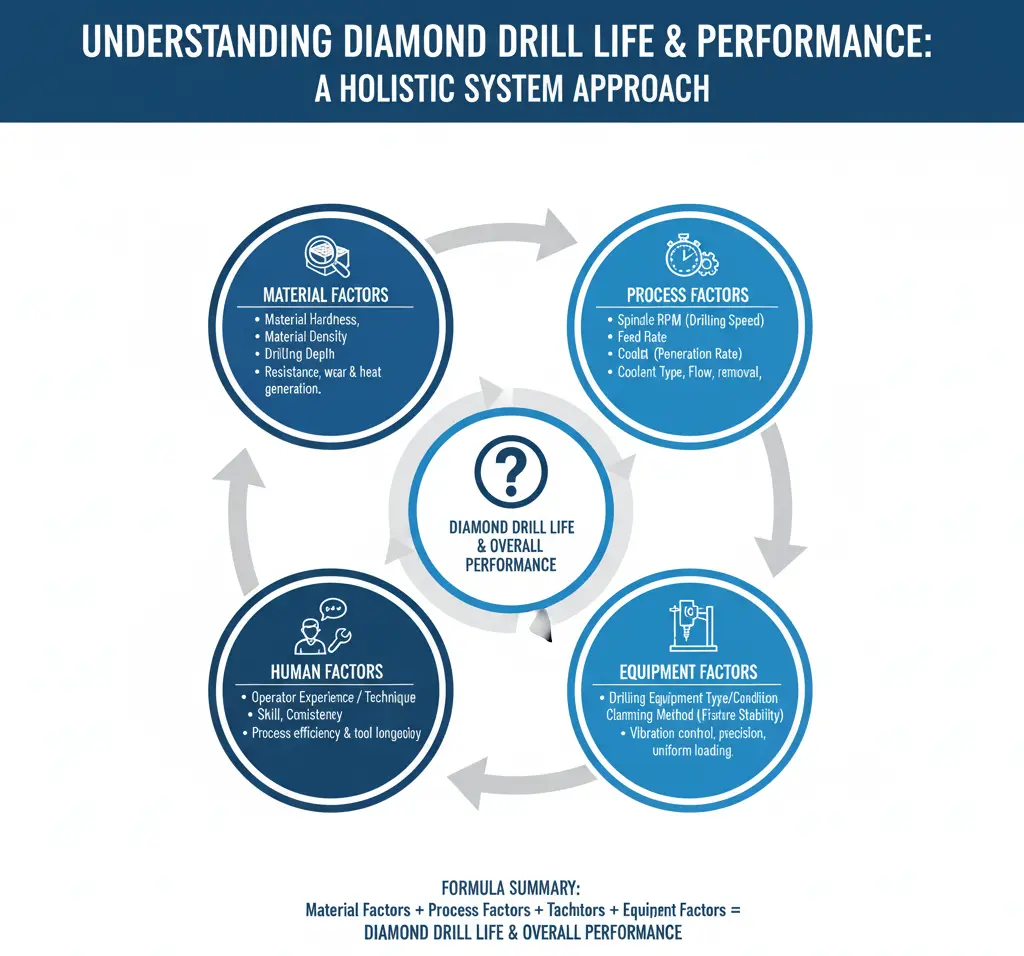
VARIABLES AFFECTING DIAMOND DRILL LIFE & PERFORMANCE

Diamond Drill Life & Overall Performance will vary with material hardness, density, Drilling Depth. Few other factors that play a role in diamond drill life include: RPM's (drilling speed), Feed Rate, Geometry (shape) of Material, Coolant being Used, Coolant feed rate and Direction. Drilling Equipment, Material Clamping Method & experience of operator. While there is now way of accurately predicting Life of your diamond drill. It can be optimized by following Principals of Proper Diamond Drill / Tool Usage.
There may also be some experimenting, as well as trial & error involved in the part of the end user. Highly experienced diamond drill users may find some variations in diamond drill life or performance even when working on same material & application for several years.
While this phenomena is not too common, it does occur. Each variable of the diamond drilling process is only one of the many components of a larger diamond drilling system (equation). Changing one component or variable of diamond drilling process cannot create efficiency alone. Only when all components of the system added together can desired outcome be achieved. Just like a mathematic equation, it takes only one incorrectly select variable/component to affect all other properly selected variables. Making the entire diamond drilling equation/system incorrect or inefficient.
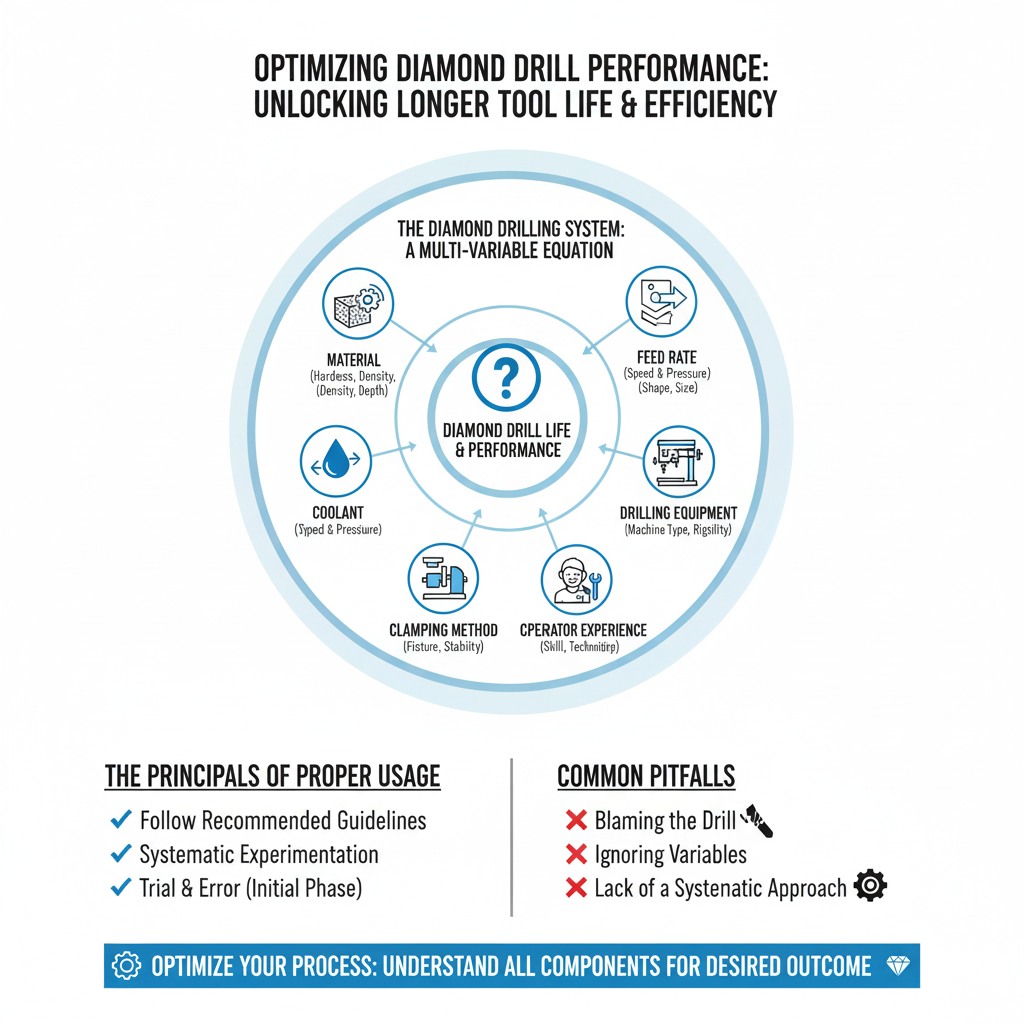
Many end users approach their diamond drilling application uninformed or misled. Errors are made in the set up phase and critical steps are skipped. When problems do surface, most rush to treat a symptom rather than the cause. Frustration leads them attribute their problems to diamond drill drill being used. What some customers refer to as serious problem for example, may be resolved by something as simple as adjusting RPM’s or feed rate. The solution can be as easy as changing mounting method, properly mounting drill in machine chuck, or educating customer about need to dress diamond drill.
The drilling environment around us is constantly changing. A slight change or variation in any variable can have significant impact on your diamond drilling results. Material being drilled can vary in composition or density even when coming from same manufacturer or source. Slight change in coolant feed rate, coolant direction, RPM's, even the way the material is held in place can make the difference. Frequently the cause of the problem may not be obvious and may take as much as several failed attempts to surface. Fore more information on optimizing your Diamond Drilling Operation to ultimate level of performance >>>

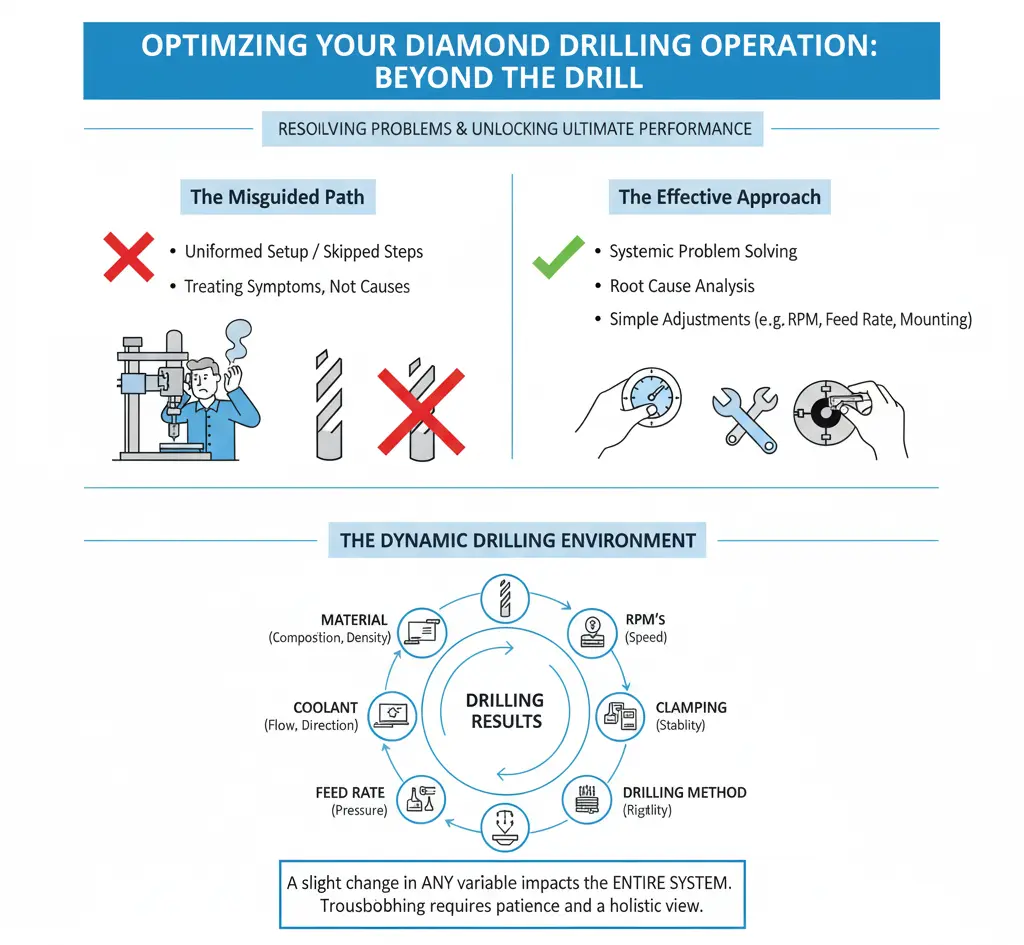
When encountering problems or variation in diamond drill performance. Few stop to think about or carefully examine their drilling process. Many users immediately suspect quality of the diamond drill and are quick in labeling the drill “Defective” or “Poor Quality”. This is very rarely the case. Usually in over 90% of these cases the diamond drill itself was not at fault. Most Respectable & Experienced Diamond Drill Manufactures (such as UKAM Industrial Superhard Tools) have rigid quality control and inspection processes set in place. Controlling everything from raw material input, output, to final inspection. What a number of diamond drill users don’t realize the technical aspects & delicate nature of diamond drilling/machining process.
Unlike carbide, high speed steel, & other types of drills. Diamond drill works by grinds away material on micro (nano) level. Carbide and other types drills on the other hand cut material with a sharp cutting edge. A simple example of the minute details and understanding that play a major role in your diamond drilling process. What is important to understand is that almost all diamond drill/bit users,
regardless of experience or technical background will make some type of an unintended operator error while using their diamond drills/bits. With this in mind, UKAM Industrial Superhard Tools has assembled a list of most common diamond drill operator errors made by users in all industries & applications. Looking through this guide will help you RESOLVE MOST COMMON DIFFICULTIES you may have in using your diamond drills/bits, as well as AVOID
|
WARNING: Diamond Drills & Diamond Drill Bits improperly used are dangerous. Comply with American National Standards institute Safety Code B71 and Occupational Safety and Health Act Covering SPEED - SAFETY - GUARDS - FLANGES - MOUNTING PROCEDURES - GENERAL INSPECTION - GENERAL MACHINE CONDITIONS.
|
|
|
WARNING: Drilling generates dust. Excessive ariborne particles may cause irritation to eyes, skin and respiratory tract. To avoid breathing impairment always employ dust controals and protection sutable to the material being drilled. In accordance with OSHA (29 CFR 1910, 1200).
|
|
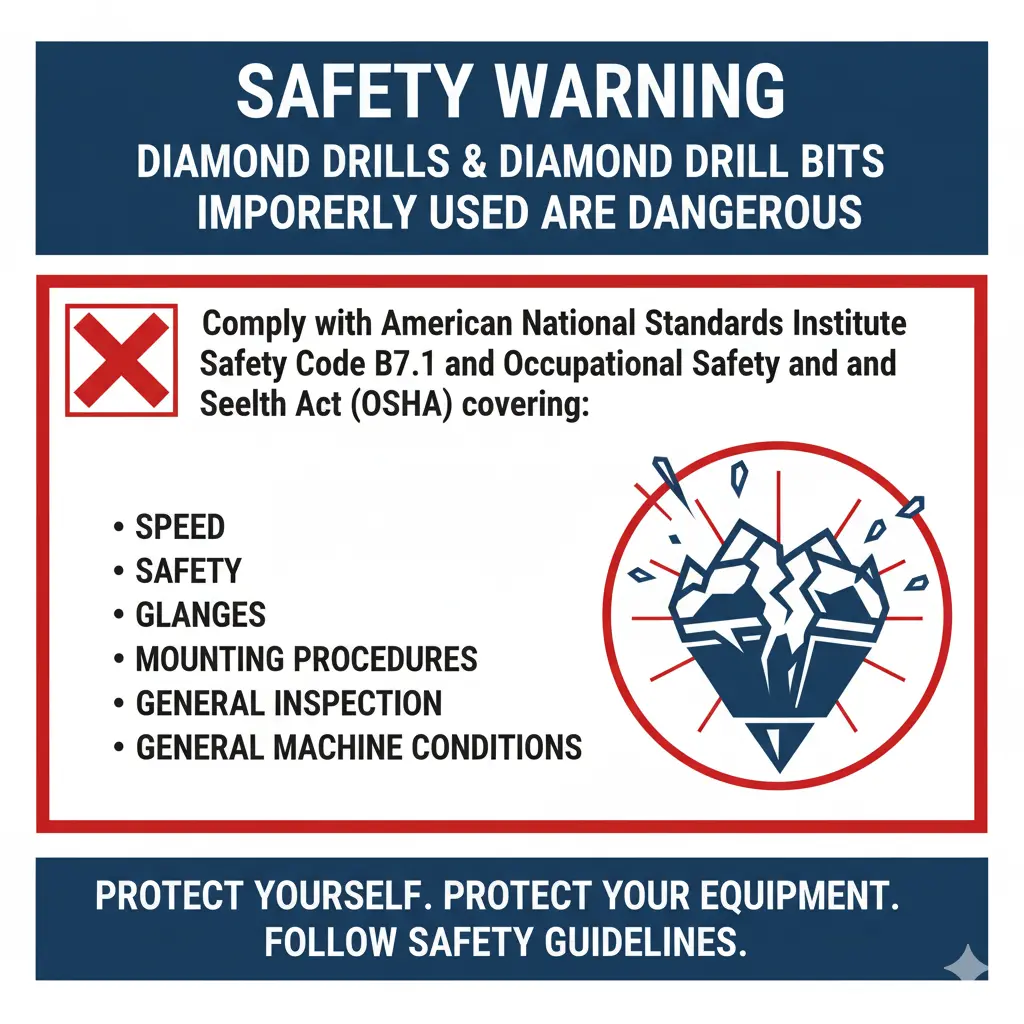
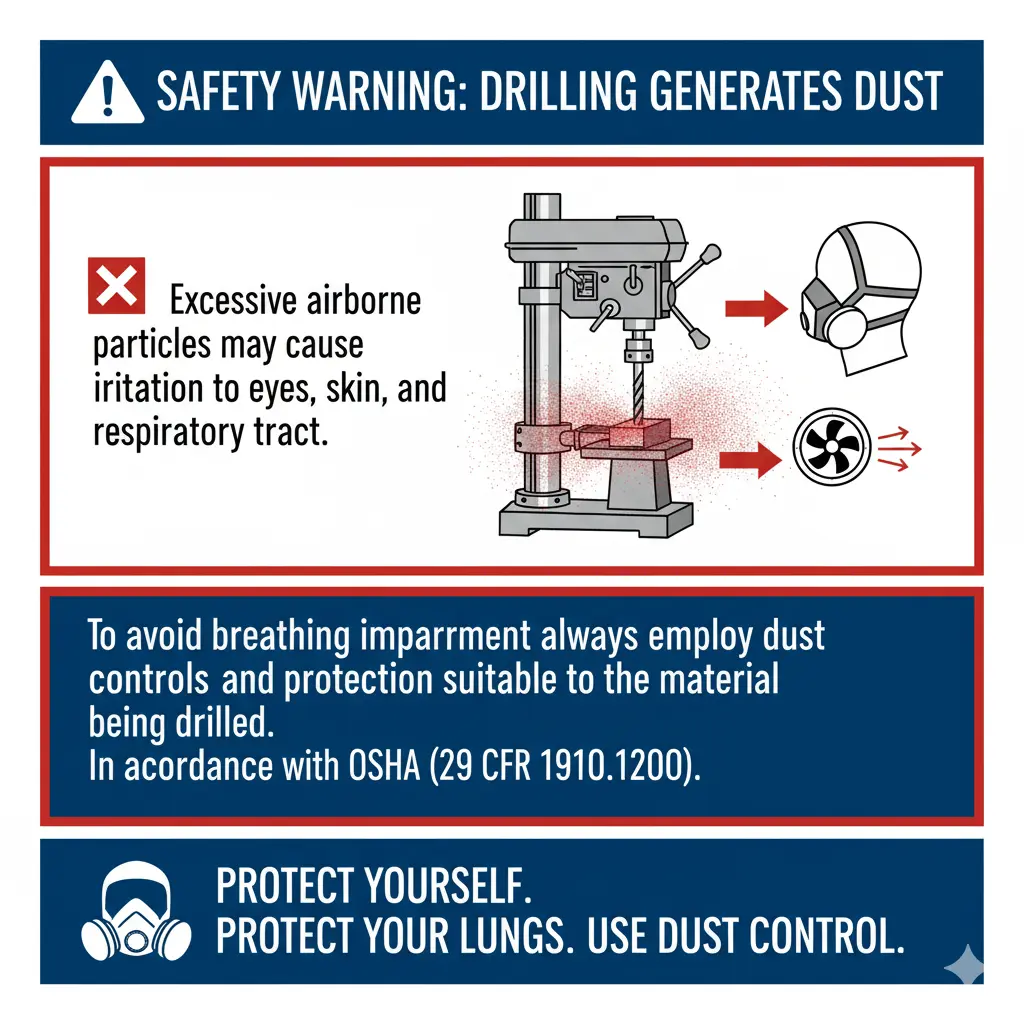

Alexander Schneider is a senior applications engineer and leading authority in the industrial diamond tooling industry, with over 35 years of hands-on experience in the development, application, and optimization of ultra-thin and high-precision diamond blades, diamond core drills, and diamond and CBN grinding wheels. His work spans a wide range of advanced materials including ceramics, glass, composites, semiconductors, and high-performance metals.
Throughout his career, he has collaborated with leading R&D institutions, national laboratories, and high-tech manufacturing companies across Europe, North America, and Asia, providing technical expertise and tailored solutions for demanding cutting and surface preparation applications.
Mr. Schneider has played a pivotal role in advancing precision cutting, sectioning, dicing, and grinding technologies used in research, production, and failure analysis. He is widely respected for his ability to optimize tool design and cutting parameters to meet exacting industry standards—balancing factors such as cut quality, blade life, material integrity, and process consistency.
As an author, Mr. Schneider is known for delivering practical, application-focused insights that translate complex technical challenges into clear, actionable strategies. His articles and technical guides serve as trusted resources for engineers, researchers, and manufacturers seeking to improve precision, reduce process variability, and enhance tool performance in critical applications.

ARE YOU USING RIGHT DIAMOND CORE DRILLS & TOOLS
FOR YOUR APPLICATION?
LET US
HELP YOU
HAVING ISSUES WITH
YOUR CURRENT DIAMOND CORE DRILLS & TOOLS?
Knowledge Center
Select Right Diamond Drill for your Application
How to Properly Use Precision Diamond Drills
Diamond Drills Guide
Diamond Tools Guide – Selecting Right Drills & Tools for your application
Optimizing your Diamond Drilling Operation
Micro Drilling Guide
Selecting Right Drilling Equipment for your Application. What you features & functionality you should look for?
Diamond Core Drill & Drill Trouble Shooting Guide
Understanding & Calculating Return on Investment for Diamond Core Drills & Other Tools
Understanding Tradeoffs – Searching for Perfect Diamond Drill & Tool
Why Use Diamond Drills?

Alexander Schneider is a senior applications engineer and leading authority in the industrial diamond tooling industry, with over 35 years of hands-on experience in the development, application, and optimization of ultra-thin and high-precision diamond blades, diamond core drills, and diamond and CBN grinding wheels. His work spans a wide range of advanced materials including ceramics, glass, composites, semiconductors, and high-performance metals.
Throughout his career, he has collaborated with leading R&D institutions, national laboratories, and high-tech manufacturing companies across Europe, North America, and Asia, providing technical expertise and tailored solutions for demanding cutting and surface preparation applications.
Mr. Schneider has played a pivotal role in advancing precision cutting, sectioning, dicing, and grinding technologies used in research, production, and failure analysis. He is widely respected for his ability to optimize tool design and cutting parameters to meet exacting industry standards—balancing factors such as cut quality, blade life, material integrity, and process consistency.
As an author, Mr. Schneider is known for delivering practical, application-focused insights that translate complex technical challenges into clear, actionable strategies. His articles and technical guides serve as trusted resources for engineers, researchers, and manufacturers seeking to improve precision, reduce process variability, and enhance tool performance in critical applications.




